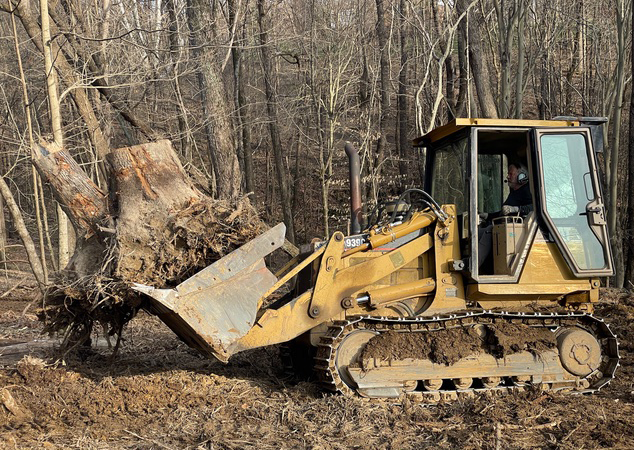Land Clearing
Land clearing is the process of removing trees, shrubs, stumps, and other vegetation from a plot of land to prepare it for agricultural, construction, or development purposes. This process is essential in transforming a wooded or overgrown area into a usable and manageable space.
 Methods of Land Clearing
Methods of Land Clearing
- Mechanical Clearing: Using heavy machinery such as bulldozers, excavators, chippers, and forestry mulchers to clear large areas quickly and efficiently. This method is effective for large-scale projects but can be disruptive to the land.
- Bulldozing: Pushing over trees, shrubs, and other overgrown vegetation then removing the debris.
- Forestry Mulching: Grinding vegetation into mulch on-site, and leaving a layer of organic material that can help with soil health.
- Excavating: Digging up stumps and roots to ensure they do not regrow, or inhibit follow construction projects.
- Manual Clearing: Using hand tools like chainsaws, weed-eaters, and axes to clear smaller areas, for more selective clearing or in conjunction with larger equipment. This method is labor-intensive but allows for more precise removal of vegetation.
- Controlled Burning: Using fire to dispose of the organic debris from the cleared land, which can be effective in certain environments, but requires careful planning and adherence to local regulations to prevent wildfires or nuisance to neighbors.
Benefits of Land Clearing
- Improved Land Usability: Transforms overgrown or wooded areas into usable land for agriculture, construction, or other purposes.
- Pest Control: Removes habitats for pests such as snakes, rodents and insects.
- Enhanced Safety: Reduces the risk of wildfires by removing excess vegetation. Clearing of trees that might be dangerous to bystanders.
- Aesthetic Improvement: Makes land more visually appealing and accessible.
- Soil Health: Can improve soil conditions by removing unwanted vegetation and allowing for better land management.
Applications
- Agricultural Development: Preparing land for farming, orchards, or livestock grazing.
- Residential Construction: Clearing plots for homes, gardens, and yards.
- Commercial and Industrial Development: Preparing sites for office buildings, factories, and other structures.
- Infrastructure Projects: Clearing land for roads, highways, pipelines, and utility installations.
- Recreational Areas: Developing parks, trails, and other outdoor recreational spaces.
- Environmental Management: Restoring habitats, managing invasive species, and maintaining forests.
Considerations
- Environmental Impact: Care must be taken to minimize soil erosion, protect waterways, and preserve habitats for wildlife.
- Regulations and Permits: Compliance with local laws and obtaining necessary permits are crucial.
- Soil Health: Consideration of soil structure and fertility, as improper clearing can lead to degradation.
- Cost and Time: The scale and complexity of the project will impact both the cost and time required for completion.
Land clearing is a critical first step in many land development projects, providing a clean slate for construction, agriculture, and other uses while also requiring careful planning to manage environmental impacts and comply with regulations.


